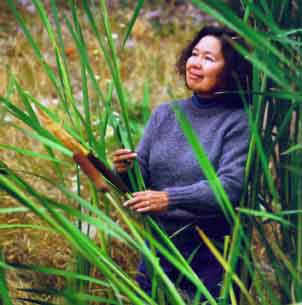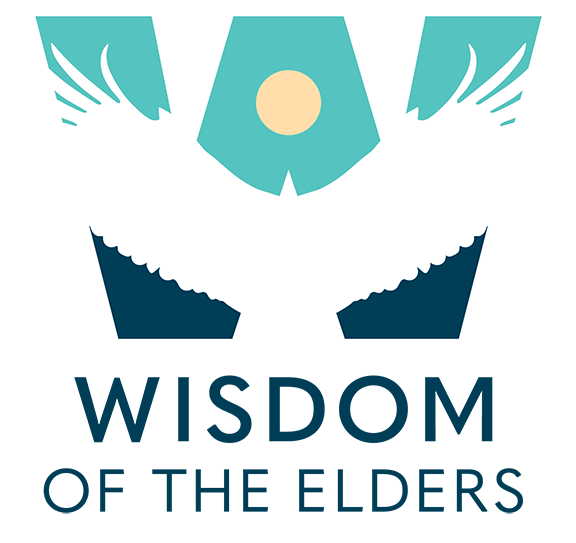Weaving History

My maiden name is Courtney and I was born and raised on the Warm Springs Reservation. The Wasco people were known for fishing and for trading. The salmon runs produced enough fish for us so that each family could catch hundreds and hundreds of pounds. We would dry this and then we would trade. The baskets were important because those were our containers. We would catch the salmon, filet them, dry them and sell them as filets or we would pound the filets into a powder salmon-like pemmican. That’s what we traded.
So the baskets were constantly being made because when we would trade the salmon we would trade a container and all. I always thought that was an interesting way to keep the skill of making baskets going.
Back to my growing up in the mountains, that was very important because I learned to appreciate nature. I loved the trees, I loved the woods, and I loved the sound of the wind in the trees. We lived by a number of smaller creeks and rivers and I loved to just sit and listen to the rivers. Now I live near a city, Portland, Oregon, what I like to do is go up into the gorge and I go hiking and just to be with the trees and stopping and listen to all the falls and the tumbling of the water coming down the falls. To me, that’s the same as going to church. It’s a very spiritual experience. Being in nature like that I learned to appreciate all the plants and the harmony of all the plants living together and how if you change one part of the habitat if you overharvest, such as the trees, it changes everything. It changes the water. It changes the plants that grow there and even though I didn’t know the word ecology, having grown up in such a close tie with the environment, I learned to really appreciate and understand the environment.
One day my sister called me, and she earned her degree in Fine Arts. She said, “We have an opportunity to learn how to weave Wasco baskets.” This was a real revelation to me because when I was growing up the only museum that was available to us was the Maryhill Museum.
The nice thing that I remember about the museum was that it was free to Native Americans. They had one of the largest basket collections. I didn’t realize it at the time until I started studying baskets. My mother would take us downstairs to the basket exhibit and show us the baskets and she would point out the Wasco baskets and say, “Our people made these.” I remember when she’d point them out because she’d have this pride in her voice showing us the baskets. That was important because when we were growing up I didn’t know anyone who made the baskets. We only had one small Wasco basket in our house. I never saw anyone weaving baskets so I didn’t think I would ever see anyone making the baskets.
When my sister telephoned me and told me that we had a chance to learn this, I thought, “I can’t believe this. I get to learn how to make these baskets.” I went and my life turned around totally because once I started learning how to make these baskets, it just opened a whole new door for me. The Wasco baskets are unique because they have geometric images. They’re also unique in the way they’re made. It’s called a full turn twine. That’s how you make these images. I learned the technique, but there was a lot that was missing in the complete knowledge of making these baskets.
When our people were moved to reservations we were moved from our traditional area so we lost contact with the traditional plants that were used. It was very difficult for about three generations of people and during that time we lost a lot of our culture. I was very fortunate that our elders at that time saved the language and we still have our language intact, but a lot of our culture was lost including this technique of weaving baskets.
When my sister and I started, one elder went to different reservations to see if she could find people who still had some relic of knowledge of these techniques, and she did. She found people who remembered parts but not the complete way to weave a basket. She helped us learn the technique, but we still had gaps. There were different ways to start the baskets. There were different ways to end the baskets, but the important part of the full turn twining to make the geometric images, she did teach us that. She taught us with yarn, wool. My sister, Orlene Borlue, and I who live in Warm Springs and she’s a Wasco, learned how to do this technique. We are the three people who helped revive this technique.
My life changed in that sense, plus I was really motivated. I just felt I had to learn how to learn the designs and to try to identify the different plant fibers that were used. The first thing I did was start researching in museums. I traveled quite extensively and museums got to know me quite well and they would invite me to come and give lectures. What I’m doing now, I’m still in the process of identifying plant fibers so now I’m going out in harvesting areas where the Elders were told their ancestors harvested. I’m just experimenting and finding all kinds of really neat materials to weave with.
The other interesting development was the need for an organized basket organization for weavers. I got together with a number of weavers throughout Washington and Oregon. The Washington Arts Commission funded us. The first gathering was to see how many people there were as weavers and do they want to be organized. Do we want to get together at least once a year and do we want to participate in classes? Do we want to go out and harvest? The main thing was, who are we because I didn’t know who half the other basket weavers were. Once we organized this, we called it the NW Native American Basket Weavers Association. We have a fantastic turnout. People identify and they brought Elders with them. I didn’t know any cedar basket weavers and I met a lot of cedar basket weavers. I met a lot of cornhusk weavers. I also met a number of Elders who were so generous in sharing their experience, where they go to harvest, what plant fibers they harvest and how to process them. That turned out to be a really fantastic organization. It put a responsibility on all of us to realize how important our culture is and we have to preserve this and we have to pass it on to the next generation.
Pat Courtney Gold
Pat is enrolled in the Wasco Nation of the Confederated Tribes of Warm Springs, Oregon. Her native heritage has thousands of years of culture and history, which influences her view of the world. With a B.A. in mathematics from Whitman College, Walla Walla, Washington, she taught mathematics at Portland-area community colleges and then worked as a mathematician-computer specialist.
Pat now devotes her time to creating art and lecturing on Plateau Tribal Art. She specializes in fiber arts, wall hangings based on Indian legends, and monoprints featuring cultural backgrounds. The Wasco basket full-turn twining method with geometric human figures and motifs are unique to the Columbia River area. She helped revive this art. Pat wants to preserve this technique and record the traditional designs.
Career highlights include 2004: Art Train, “Contemporary Native Art” Traveling Exhibit through 2007; “Lewis and Clark Territory-Contemporary Artists Revisit Place, Race, and Memory”, Tacoma Art Museum, Tacoma, Washington. 2003: Guest curator for “Reflecting on Lewis and Clark, Contemporary American Indian Viewpoints,” Maryhill Museum of Art, Goldendale, Washington; Featured artist, Oregon Public Broadcasting, Portland, Oregon. 2002: Community Spirit Award, First Peoples Fund, Denver, Colorado: “Instructors Basketry; National Basketry Organization”, Lew Allen Gallery, Santa Fe, New Mexico; “Cultural Edge II”, Lower Columbia College, Longview, Washington; 2001: Governor’s Arts Award, Salem, Oregon; 2000: “Anticipating the Dawn, Indigenous 2000” one-woman exhibit, Corvallis Art Center, Corvallis, Oregon; 1999: Invited Artist, Women’s Caucus for Art, Professional trip to China; “By Hand Through Memory”, High Desert Museum, Bend, Oregon; “A Gathering: Native Art from the Pamplin Collection” , Maryhill Museum, Goldendale, Washington; Exhibitor and Invited Lecturer on Plateau Basketry, Maxwell Museum, Albuquerque, New Mexico; “Treasures of Oregon, Traveling Exhibit, Oregon Historical Society; 1998: Artist in Residence, National Museum of American Indians, New York City; Master Artist, Oregon Folk life Program, Portland, Oregon; 1997: “To Honor and Comfort: Native American Quilts”, Smithsonian Museum, New York; “Rising From Tradition”, High Desert Museum, Bend, Oregon; Invited Speaker, The International Weaving Conference, Rotorua, New Zealand; 1996: “One Woman Show, “Wasco Legacy,” Maryhill Museum, Goldendale, Washington; “The Spiral Path; Contemporary Northwest Weavers”, Seattle Art Museum, Seattle, Washington; 1995: Invited guest, Indigenous Art Symposium, Rotorua, New Zealand.
Pat’s work is in museum collections and has been exhibited nationally and internationally. Oregon: Portland Art Museum; Natural History Museum, University of Oregon, Eugene; Oregon Historical Society, Portland; Haille-Ford Museum, Salem; High Desert Museum, Bend; The Governor’s Office, Salem; Littman Gallery, Portland State University; Museum at Warm Springs; Interstate Firehouse Cultural Center, Portland. Washington: Maryhill Museum, Goldendale; Seattle Art Museum; Tacoma Art Museum; Northwest Folk Life Festival, Seattle. National: Peabody Museum, Harvard University, Cambridge, MA; Perry Galleries, Alexandria, VA; Lew Allen Gallery, Santa Fe, NM; Smithsonian National Museum of the American Indian, NY; Maxwell Museum, Albuquerque, NM; Schoolhouse Gallery, Damariscotta, ME. International: British Museum, London, England; Hei Tiki Gallery, Rotorua, New Zealand; private collection, Germany.
Pat will be featured on Wisdom of the Elders Radio: Series Three – Program Five featuring the Warm Springs Tribe on Artist’s Circle at www.wisdomoftheelders.org.
Pat Courtney Gold
PO Box 981
Scappoose, OR 97056
503-543-3584
sallybag9@yahoo.com
